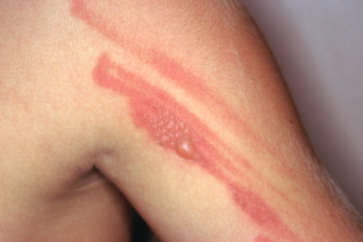Phytophotodermatitis (Berloque dermatitis) is dermatitis caused by skin contact with light-sensitizing botanical substances, also known as furanocoumarins, and long-wave ultraviolet A (UV-A, 320-380 nm) radiation. ICD-10 Code: L56.2
The most common triggers of phytophotodermatitis include ingredients in cosmetics (fragrances, essential oils of bergamot, lime, sandalwood, lemon and cedar), poison ivy, St. John's wort, parsley, celery, parsnip, lime, fig and some wildflowers.
Berloque Dermatitis
Phytophotodermatitis
Diagnosis is based on the patient's history and clinical presentation.
Laboratory Tests
- Complete blood count and urinalysis, blood biochemistry.
- Examination of autoantibody levels in the blood, including antinuclear antibodies, antibodies to double-stranded (native) DNA, Sm, Ro/SS-A, and La/SS-B antigens, etc. (conducted to rule out lupus erythematosus).
- Examination of porphyrin levels in blood plasma, erythrocytes, and urine (conducted to rule out porphyria).
- Chronic actinic dermatitis
- Contact dermatitis
- Eczema
- Lupus erythematosus
- Porphyria cutanea tarda
- Other photodermatoses and diseases whose course may be aggravated by sunlight or ultraviolet light (atopic dermatitis, seborrheic dermatitis, erythema multiforme, etc.).
General Remarks
- Symptomatic therapy is prescribed to alleviate skin eruptions. If blisters are present, they should be drained. Apply cold compresses or wet-dry dressings to areas of erythema and skin swelling.
- Use of moisturizers and topical glucocorticosteroids is recommended, but there is no clear evidence of their effectiveness. For the treatment of acute inflammatory symptoms, glucocorticosteroids are prescribed in form of emulsions, lotions or creams.
- In some cases, antihistamines may be recommended.
- In severe reactions, systemic glucocorticosteroids are used.
Systemic treatment
Antihistamine Medications
- Loratadine 5-10 mg orally once a day for 7-10 days OR
- Cetirizine 5-10 mg orally once a day for 7-10 days OR
- Ebastine 5-20 mg orally once a day for 7-10 days OR
- Levocetirizine 5 mg orally once a day for 7-10 days.
Systemic Glucocorticosteroids
Prednisone 60-80 mg per day orally for several days with subsequent dose reduction until discontinuation.
Topical treatment
Topical Glucocorticosteroids
- Mometasone furoate applied externally 1-2 times a day as applications OR
- Methylprednisolone aceponate applied externally 1-2 times a day as applications OR
- Alclometasone dipropionate applied externally 1-2 times a day as applications OR
- Betamethasone valerate applied externally 1-2 times a day as applications OR
- Betamethasone dipropionate applied externally 1-2 times a day as applications OR
- Fluticasone propionate applied externally 1-2 times a day as applications OR
- Hydrocortisone butyrate applied externally 1-2 times a day as applications OR
- Clobetasol propionate applied externally 1-2 times a day as applications.
Treatment course: 2-4 weeks.
Prevention
Persons involved in harvesting agricultural crops should be informed about plants that may cause phytophotodermatitis. In agricultural work, it is not recommended to harvest plants immediately after rain or morning dew. Skin should be protected with sunscreen and protective clothing (gloves, sleeves, pants, and socks).


